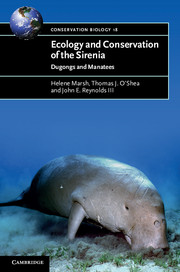Book contents
- Frontmatter
- Contents
- Foreword
- Preface
- Acknowledgements
- 1 Introduction
- 2 Steller’s sea cow
- 3 Affinities, origins and diversity of the Sirenia through time
- 4 Feeding biology
- 5 Behaviour and habitat use
- 6 Life history, reproductive biology and population dynamics
- 7 Threats
- 8 Conservation status
- 9 Conservation opportunities
- References
- List of online supplementary material
- Index
- Plate section
6 - Life history, reproductive biology and population dynamics
Published online by Cambridge University Press: 05 January 2012
- Frontmatter
- Contents
- Foreword
- Preface
- Acknowledgements
- 1 Introduction
- 2 Steller’s sea cow
- 3 Affinities, origins and diversity of the Sirenia through time
- 4 Feeding biology
- 5 Behaviour and habitat use
- 6 Life history, reproductive biology and population dynamics
- 7 Threats
- 8 Conservation status
- 9 Conservation opportunities
- References
- List of online supplementary material
- Index
- Plate section
Summary
Introduction
As explained in Chapter 3, sirenians evolved from primitive terrestrial herbivores early in the Tertiary period. Like whales and dolphins (cetaceans) but unlike the pinnipeds (walruses, seals and sea lions), manatees and dugongs spend their entire lives in the water and do not return to land to give birth and suckle their young. Sirenians are believed to share a common origin with several superficially dissimilar mammals of African origin, grouped together at the superordinal level as the Afrotheria. Within the Afrotheria the sirenians are closely aligned with elephants and hyraxes, and the three have been linked together as the clade Paenungulata, a unique grouping recognised for most of the last century (see Chapter 3). Although features of the external form of sirenians reflect adaptations to their lives of swimming and diving, the phylogenetic history of dugongs and manatees is reflected in features of their reproductive biology, which in some respects is strikingly similar to that of elephants (as outlined under ‘Reproductive cycles’ below and in the Supplementary Material Appendix 6.1).
Understanding the life history and reproductive biology of sirenians is fundamental to the development of effective strategies for their conservation. For example, knowledge of when and where they breed is important for assessing the effectiveness of establishing sanctuaries or other protected areas to protect breeding habitat. In addition, knowledge of the mating system (Chapter 5), the average ages at which females start breeding, the litter size, average inter-birth interval, life span and the probabilities of reproduction and survival, and how these parameters are affected by age and changing environmental conditions, are essential for understanding the population dynamics of manatees and dugongs. Knowledge of population dynamics is a requisite for sound management policies and for estimating the levels of human-induced mortality that are likely to be sustainable. In this chapter, we characterise the biology of reproduction in the Sirenia, and describe the methodological and analytical approaches that have been taken over the years to determine their vital parameters of reproduction and survival. We summarise the results of these studies and then review how information about vital parameters has been incorporated into models of sirenian population dynamics and the implications of these models for future research and management.
- Type
- Chapter
- Information
- Ecology and Conservation of the SireniaDugongs and Manatees, pp. 209 - 262Publisher: Cambridge University PressPrint publication year: 2011



